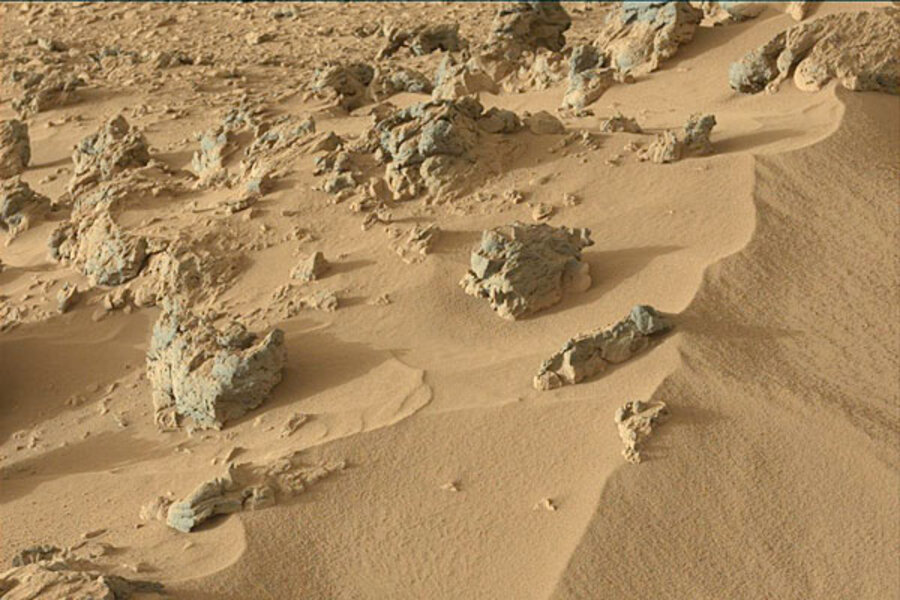Curiosity's unsung skill: scouting Mars for a human mission
Loading...
Hey, Curiosity! Are you sure you're not in Kansas?
Earlier this month, two tiny twisters buffeted NASA's Mars rover Curiosity in the space of 11 minutes. They were two of 21 whirlwinds the rover has detected from its home in Gale Crater so far – with more expected as Mars' southern hemisphere enters its spring and summer.
In one sense, this seems like a ho-hum observation. Whirlwinds and dust devils are common on Mars, although no evidence of them had been found in images of Gale Crater taken from orbit.
But they represent a very important element of the planet's dust cycle, which is a key driver of Mars' climate, says Manuel de la Torre Juarez, a physicist at NASA's Jet Propulsion Laboratory in Pasadena, Calif. Their presence inside the crater, combined with the most sophisticated atmospheric monitoring station humans have landed on the planet, give scientists an unprecedented opportunity to unravel the role these mini-twisters play in Mars' current climate.
The opportunity highlights a little-heralded role for Curiosity, whose primary mission is to analyze rocks and soil to determine if the crater might have once been a suitable habitat for microbial life. The rover and its weather station and radiation monitor are monitoring today's environment, both with an eye toward understanding the evolution of the planet's atmosphere over billions of years, but also as a gauge of the hazards astronauts might face during a potential mission.
One story that is unfolding involves the changing thickness of the atmosphere with each Martian day, called a sol, and even with seasonal changes. Those changes impact the amount of radiation – cosmic rays and charged particles from the sun – reaching the surface.
For instance, sensors on the Rover Environmental Monitoring Station (REMS) have detected an unexpected and large day-night shift in atmospheric pressure, corresponding to changes the sun brings to the atmosphere. During the day, the atmosphere heats, expands, and grows less dense as it does so. This reduces the amount of pressure the atmosphere exerts on pressure sensors. At night, when temperatures drop to about minus 130 degrees Fahrenheit, the pressure increases as the atmosphere contracts and grows more dense.
At the same time, the rover's Radiation Assessment Detector (RAD) has found that cosmic and other forms of radiation peak during the day and drop at night as changes to the atmosphere thicken or thin this tenuous shield.
REMS's pressure sensors also are picking up a longer-term shift in pressure as the southern hemisphere moves into spring and summer, notes Claire Newman, a scientist with the Ashima Institute in Pasadena and a member of the REMS science team.
"The entire Martian atmosphere is growing in size," she says, as the south pole ices vaporize. "Each year, the Martian atmosphere shrinks and grows by about 30 percent because a portion of the atmosphere is freezing out to the poles in fall, then vaporizing again in spring. That, of course, is unlike anything we see on Earth."
Teasing out these cycles and their effect on the levels of radiation reaching the surface are important because "radiation is a life-limiting factor for habitability," says Don Hassler, a scientist with the Southwest Research Institute in Boulder, Colo., and the lead investigator for RAD. The information also is important in designing a safe mission for astronauts.
Indeed, RAD represents the first time humans have measured surface-radiation levels on any planet other than Earth.
But for that Dorothy and Toto kind of feel, nothing beats the dust devils. These features tend to form when warm air at the ground quickly rises into a patch of cooler air. If conditions are right, the narrow column of warm air begins to rotate, thinning as it rises, which increases its spin. Additional warm air near the surface can get drawn into the vortex, perpetuating the mini-twister as it pirouettes across the Martian surface.
As twisters go, these are among the the solar system's 98-pound weaklings. If an astronaut happened to be standing by the rover when one passed, dust might have obscured her view briefly, but she wouldn't have felt a thing because the Martian atmosphere is so thin.
Still, collectively, dust devils join dust storms in kicking up silt that warms the Martian atmosphere, says Dr. de la Torre Juarez, the investigation scientist for REMS.
In addition to their effect on climate, they can give new life to dust-covered solar panels by sweeping the panels free of accumulated silt. The rovers Spirit and Opportunity experienced the cleaning power of dust devils.
But dust devils also can threaten technology on the surface. On Mars, they can grow up to 100 times bigger than Earth's dust devils. As they spin, collisions among the dust particles can build up charges of static electricity that can affect sensitive instruments.
"That's an active area of study," de la Torre Juarez says.
And as for the Curiosity-Kansas connection, there actually is one. The rover's name was submitted in 2009 by Clara Ma, then a sixth-grader who hailed from Lenexa, Kan.







